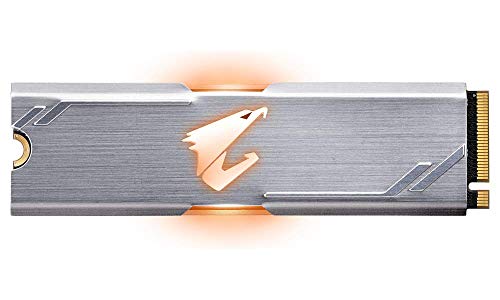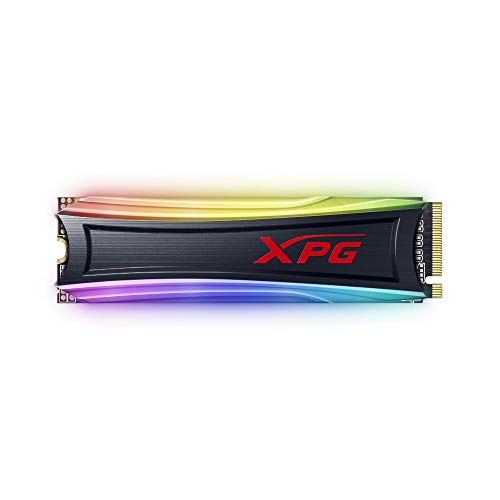Table of Contents
Even though an SSD is an internal component in your PC, it is one that you can still see if you’ve got a tempered glass side panel on your case. And with all the RGB craze in desktop PC builds nowadays, a couple of manufacturers decided to make some of the best RGB SSDs on the market.
While RGB doesn’t have any kind of impact on the performance of your solid-state drive, it does have quite the visual impact. Therefore, when choosing an RGB SSD, you’ll want to consider the performance of it first, as that’s what matters, but do take a look at how the RGB lights work and how much they’ll impact your system’s aesthetics.
What should you look for in an RGB SSD?
Form Factor
The first thing to know when you’re getting an SSD is the form factor. Not only do different form factors have different speeds, but they use a different interface to connect to your computer. This means that if your motherboard doesn’t support a specific form factor, you just can’t add that type of SSD to your system. There’s NVMe, which comes in either a PCIe or an M.2 form factor, and there are SATA drives. NVMe ones will connect to your system electrically, and are lightning-fast. SATA, even SATA III which is the latest and fastest standard, is still slower and a serious bottleneck for most SSDs.
Read and Write Speeds
The next important thing is the read and write speeds. This is the actual speed at which you’ll be able to transfer files to and from the SSD and directly translates into performance. With a SATA III drive, you can’t expect more than 600 MB/s throughput. On the other hand, with an NVMe drive, those speeds can go up to 3,500 MB/s. That’s 7 times SATA III’s maximum speed. If your computer supports an NVMe drive, by all means, get one.
Storage Capacity
Then, you have storage capacity. With storage it’s usually “get the largest drive you can afford”, but lately, 500GB seems to be the sweet spot when we’re looking at the price-to-capacity ratio. If you’re only looking for a boot drive, you may get away with as little as 120GB, but with today’s games, you’ll want more – a single game can easily reach 25GB or more.
Durability and Reliability
Last but not least, we have durability and reliability. Reliability is defined by MTBF or Mean Time Between Failures. MTBF is the predicted elapsed time between a mechanical or electronic system’s inherent failures during normal operation. You can expect an SSD to last longer than a regular hard drive, since there are no moving parts, and most SSDs are pretty reliable nowadays. You also have the temperature to consider, especially with RGB SSDs where the lights will give out a bit more heat than a regular drive would. However, most manufacturers add some kind of improved cooling system to their RGB SSDs, which makes sure they stay cool and don’t cause any issues.
NVMe M.2 RGB SSDs: Reviews
-
XPG S40G
XPG’s S40G is one of the mostversatile RGB SSDs out there. It comes in a few capacities (256GB, 512GB, 1TB),and is a PCIe NVMe drive with speeds of up to 3500MB/s (read) and 3000MB/s(write). This is pretty impressive, but do consider that speeds may varyslightly with different capacities. With an M.2 2280 form factor, you can fitthis in any motherboard that has such a slot.
The RGB lights are on both sidesof the drive. What’s interesting is that the lights are made to be compatiblewith RGB software by most major motherboard manufacturers. Therefore, chancesare it will be recognized in the software pretty quick, taking a lot of thehassle out of things. With a MTBF of 2 million hours, this is also one of themost durable SSDs out there, and definitely one to add to your shortlist if youwant a fast drive with RGB and excellent performance.

|
-
addlink X70
The fact that addlink isn’t themost popular SSD brand out there allows them to get you an excellent SSD at apretty affordable price. The X70 in a 1TB capacity comes with a PCIe NVMeinterface that lets it reach speeds of up to 3400MB/s read and 3000MB/s write,which is impressive.
The drive itself is an M.2 2280model, but due to the RGB lights it is pretty thick, so make sure it can fityour motherboard before you buy. If it does, though, the RGB lights are addedto the heatsink that keeps the controller cool, and you’ll get a greatperforming and great looking SSD.
With 3D NAND inside, durabilityand longevity won’t be an issue, even with repeated reads and writes. The MTBFis 1.8 million hours, and with 1200 TBW, you won’t need to replace it anytimesoon.

|
-
Gigabyte AORUS RGB NVMe M.2

The capacity is 256GB, which should fit your OS, your most commonly used software, as well as a few games. You can also get the 500GB version of this RGB SSD if you require a larger capacity.
In terms of the looks, the AORUS comes with an integrated silver heatsink to keep things cool. There’s a light-up logo that supports Gigabyte’s RGB Fusion 2.0, and the SSD looks really well. You should be able to fit it in just about any color rig, and it will look stunning.

|
SATA RGB SSDs: Top Picks
-
TEAMGROUP T-Force Delta MAX SATA III

With a capacity of 250GB, 500GB, and 1TB, you should have no problems fitting your OS, software, as well as a few games depending on what capacity you select. It supports both TRIM and S.M.A.R.T. technologies too.
When it comes to the look, the T-Force Delta MAX has a very big RGB area. It has a built-in rainbow color effect, but unfortunately, you can’t control it via software. It’s compatible with motherboards that have USB 9pin headers, which is required for the backlight.

|
-
TEAMGROUP T-Force Delta S SATA III

With a 250GB or 500GB capacity, it should fit your operating system, applications, and a fair amount of games depending on what capacity you select.
In terms of the RGB lights, you’ll get a 16.8 million color backlit area, with a configurable, single-color lighting effect. The backlit area is very large, and it will look stunning, especially if you have other RGB components in your build.

|
-
HyperX Fury RGB SSD SATA III

On the outside, you get an aggressive design that’s built around the RGB lights, making them stand out. The SSD can be daisy chained to other RGB devices if you want to sync the light effects, or connected straight to the motherboard for software control. Whichever you go for, it looks stunning.

|
-
TEAMGROUP T-Force Delta S TUF SATA III

When it comes to the physical look and the RGB lights, the T-Force Delta S TUF is certified by the TUF Gaming Alliance, and the lights support synchronization with the lighting effects on ASUS motherboards. This means you’ll be able to control the lights and make them match the rest of your build.

|



